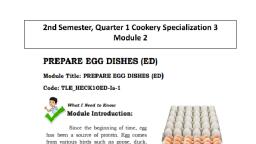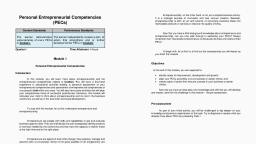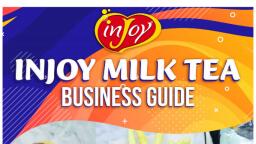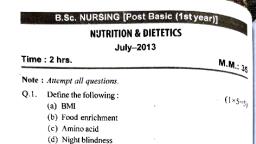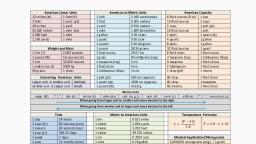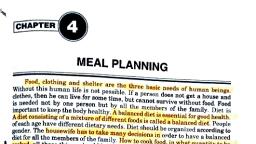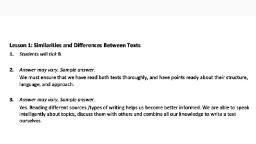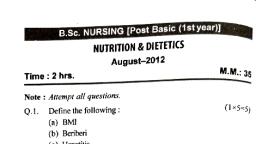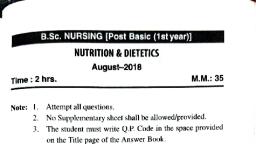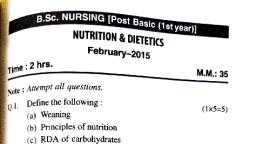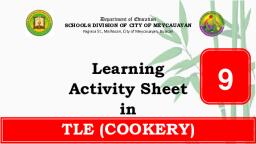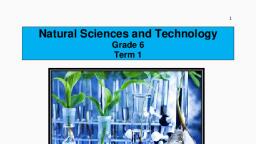Page 1 :
Bread, and, BOOK, Pastry, Production, Grade 12
Page 2 :
Hello and welcome, to our first SOC for, nd, 2 semester
Page 3 :
Introduction, to Bread, and Pastry, Production, , Before engaging oneself in the Bread, and Pastry Production industry, One, must know the different ingredients used, in baking and its substitution. This will, help in creating or finding options for, baking different bakery products. This, skill can be acquired by identifying, ingredients used in baking, proper storing, and handling of baking ingredients,, familiarizing oneself with the table of, weights and apply basic mathematical, operations in calculating weights and, measure.
Page 4 :
Basic Ingredients in Baking, , Flour, , Sugar, Leavening Agent, , Egg, , Shortening
Page 5 :
What is Flour?, , 1. Finely ground meal obtained, by grinding and milling, cereal grains or other root, crops., 1, 2. When mixed with water, this, proteins form as gluten., 3. The more, protein, a, flour, has,, 2, the stronger the gluten, strength., 4. Functions, as gluten, 3, development.
Page 6 :
Types of Flour, Types of Flour, Bread Flour or Hard Flour, , Protein- Content, 12-14%, , Gluten- Content, Strongest gluten strength, , Milled from, Hard Wheat Flour, , • The high gluten content causes the bread to rise and gives its shapes and structure, , All-purpose or General Purpose Flour, or Family Flour, , Pastry Flour, , Cake Flour, , Blend from hard and soft wheat flour, , 10-11%, , Varies from 89%, , Slightly more gluten than cake, flour, , Usually from soft wheat, , 7-9%, , Low in gluten, , Soft wheat, , It is good for making cakes and cookies where a tender and delicate texture is desired., , Soft Flour, , Lowest in gluten
Page 7 :
Sugar, , 1. Sweet, soluble organic compound that, belongs to the carbohydrate group of, food., 2. They are the simplest to digest among, all carbohydrates., 3. Functions as food for the yeast.
Page 8 :
Types of sugar, •Regular granulated sugar or white sugar – also known as “table, sugar”, •Confectioner’s sugar or powdered sugar – granulated sugar that, 1, has been pulverized.To prevent lumping and caking, about 3%, cornstarch is added., , 3, 4, •Brown, Sugar – contains caramel, mineral, matter and moisture. It, also contains a small amount of molasses.
Page 9 :
The backbone of many baked goods and contribute to its, structure., 1., , Egg, , 2. Eggs, , also provide steam for leavening or moisture for, , starch., 3. Represent almost 50% of the total cost of any baked, product, thus considered the baking ingredient with the, highest cost or expense., 4. Egg yolks add moisturizing fat and helps emulsify the, batter, giving the baked good a smooth and creamy, texture., 5. The egg whites act as strengtheners. There are substitutes, for fresh eggs, but they do alter the recipe.
Page 10 :
Shortening, , • Shortening is any fat, which when added, to flour mixtures increases, tenderness., • This is done by preventing the sticking, of gluten strands while mixing so that, gluten is shortened and makes the, product tender., , • Function to shorten the gluten strand.
Page 11 :
Types of, Shortening, 1. Oil - Made from plant products such as corn, cottonseeds,, soybeans, peanuts and other sources., 2. Butter - Animal-based and made of fatty milk proteins., 3. Margarine - Plant-based and made from hydrogenated vegetable, , oil., 4. Lard - Animal-based and made from fats of pork
Page 12 :
Leavening, Agent, , Leavening Agent are gases that cause the, , dough to "rise"., They do this by providing air, steam, or gas., 1. Yeast, , 2. Baking soda is a quick-acting leavening agent., It is only used when acids are present…the most, common of which is “cream of tartar”, 3. Baking powder is the most common of the quick-acting, leavening agents. It is a combination of soda and acid.
Page 13 :
Note: Quick-acting leavening agents are, used in cakes and cookies., , Classification of Leavening agent, 1. A biological leavener is a substance used to make, baked products lighter by helping them rise — yeast., According to “Cook's Thesaurus,” yeast is a one-celled, fungus that converts sugar and starch into carbon dioxide, bubbles and alcohol, which make dough rise.
Page 14 :
2. Chemical, , Leavening agent, , Baking Soda. Chemically known as sodium bicarbonate, baking soda is a, type of salt that's made by mixing carbon, sodium, hydrogen and oxygen, molecules. ..., •Baking Powder. This ingredient is a mixture of baking soda and powdered, acids. ..., •Cream of Tartar., , 3. There are two types of physical leaveners: air and steam. Air is, often incorporated into batters when butter and sugar are creamed, together. Briskly whisking butter (or another solid fat) with sugar traps, small pockets of air within the fat. Air can also be used as a leavener, when whipping egg whites or cream.
Page 15 :
Liquid, 1. Mix with flour to develop gluten., 2. Gluten helps form structure of a baked good, 3. Milk and water are the most common., 4. Water is the liquid used in baking, 5. Milk adds flavor, nutrients and promotes, Browning, 6. Buttermilk: tangy flavor, makes the mixture, more acidic, determines the kind of leavening, agent needed.
Page 16 :
Minor ingredients in Baking, , • Essential in attaining the sensory qualities of baked products., • They are used in small quantity, but contribute to the enhancement of, flavor and texture of the baked products.
Page 17 :
Flavorings, •Fruits and nuts add flavor and texture to baked, products., •Herbs, spices, extracts used in small amounts add flavor, •Examples of extracts (liquid) lemon, vanilla, almond
Page 18 :
Difference between Extract and, Flavor Emulsion, •Flavor Extract is alcohol-based, •Flavor Emulsion is oil-based or fat-based
Page 19 :
Salt, •Salt adds flavor, •Strengthens gluten, •Salt enhances the sweetness of other ingredients in a, baked product.
Page 20 :
Types of Chocolate, •Unsweetened Chocolate, •Bittersweet and semisweet Chocolate, •Milk Chocolate
Page 21 :
Proper Storing and Handling of, Baking Ingredients, 1.Store in a clean and dry area., 2.Store away from odorous materials and areas prone, to infestation., 3.Store in a well-ventilated area free from roof leaks, and/or condensates., 4.Palletize properly to prevent caking., 5.Prioritize proper stock rotation such as First In, First, Out (FIFO).
Page 22 :
STANDARD TABLE OF WEIGHT AND MEASURE, DISCUSSION, , 1 tablespoon (T or tbsp), 2 tablespoon, 4 tablespoon, 5 1 / 3 tablespoon, ¾cup plus2 tablespoons, 1 6 tablespoon, 2 cups, 4 cups, 1 6 ounces, , = 3 teaspoon ( t or tsp. ), = 1 / 8 cup, = ¼cup, = 1 / 3 cup, = 7/8 cup, = 1 cup( c. ), = 1 pint, = 1 quart, = 1 pound, , COMMON UNITSOF WEIGHT, , 1 pound ( lb.), 1 ounce, 1 kilogram ( kg. ), 1 gram, 1 medium orange, 1 medium apple, 1 4 oz. can condensed milk, 1 4 oz, can evaporated milk, 1 lb. brown sugar, 1 lb. confectioner sugar, 1 lb. confectioner sugar, 1 lb. nuts, 1 lb. dried nuts, 5 whole eggs, 1 2 egg yolks, 8 egg whites, , = 463.59 grams, = 28.35 grams, = 2.21 pounds, = .035 ounces, = ¼to ½cup ( slice ), = 1 cup slice, = 1 ¼cups, = 1 2/3 cups, = 2 ¼cups (packed), = 3 ½cups, = 2 ½cups, = 4 ½cups, = 2 cups, = 1 cup, = 1 cup, = 1 cup, , COMMON UNITS OF VOLUME, , 1, 1, 1, 1, , bushel (bu ), peck (pk ), gallon (gal.), quart, , = 4 pecks, = 8 quarts, = 4 quart, = 2 pints, = 964.4 milliliters, = 4.9 milliliters, 1 teaspoon ( tsp. or t.), = ½fluid ounce, 1 tablespoon (T. or tbsp. ), = 14.8 milliliters, = 3 cups, 1 5 ounces raisins, = 2 ½- 3 cups, 1 pound dates, ½pint whipping cream, = 2 cups whipped creams, , 1, 0
Page 23 :
BAKING INGREDIENTS SUBSTITUTIONS, Ingredients, 1 Cup Brown Sugar, 1 Bar Butter, 1 Cup Buttermilk, 1 Cup Self-Rising Flour, 1 tsp. Cream of Tartar, 1 Cup Evaporated Milk, 1 Cup Corn Syrup, 1 tsp. Lime Juice, 1 Cup Molasses, 1 Cup Yogurt, 1 Cup Heavy Cream, 1 tbsp. all purpose, flour, , Substitute, ¼ Cup Molasses + 1 Cup Sugar, ½ tsp. Salt + 7/8 C vegetable oil, 1 Cup Yogurt, ½ tsp. salt + 1 ½ tsp. baking powder + 7/8 Cup APF (All-Purpose Flour), 2 tsp. Lemon Juice, 1 Cup Cream, 1/3 C. Water + 1 ¼ C. Sugar, 1 tsp. Vinegar, ¾ C. Brown Sugar + 1 tsp. Cream of Tartar (COT), 1 C. Sour Cream, 1/3 C. Butter + 1/3 C. Milk, ½ tbsp. cornstarch/ potato starch / rice starch, , 1 Cup Sour Milk, , 1 Cup Evaporated Milk + 1 T. vinegar or lemon, juice, , 1 Cup cake flour, , 1 C. All-Purpose Flour Minus 2Tbsp + 2Tbsp., Cornstarch/Wheatstarch (Sift three to five times), , 1 Cup granulated sugar, , 1 1/3 cup brown sugar, , 1 Cup honey, 1 ounce chocolate, 1 tbsp. baking powder, 1 tsp. active dry yeast, 1 square unsweetened, chocolate, , 1 ¼ cup sugar plus ½ cup liquid, 3 tbsp. cocoa plus 1 tbsp. fat, 1/4 tsp. baking soda plus ½ cup soured milk, 7 g instant dry yeast, , 1 Cup butter, 1 Cup heavy cream, 1 Cup coffee cream, , 1 Cup margarine; 7/8 cup of lard plus ½ tsp. salt, ¼ Cup butter plus ¾ cup of milk, 3 tbsp. butter plus 7/8 cup milk, 1 Cup non-fat dry milk plus 2 ½ tsp. of butter or, margarine, 3 tbsp. of sifted non-fat dry milk plus 1 cup water, , 1 Cup whole milk, 1 Cup milk, , 3 tbsp. cocoa plus 1 tbsp. fat
Page 24 :
OVEN TEMPERATURES, °F = °C X 9 / 5 + 32, , °C = °F – 32 X 5 / 9, , TEMPERATURE CONVERSION TABLE, °CENTIGRADE (°C) TO °FARENHEIT (°F), 50 – 122, , 110 – 230, , 170 – 338, , 230 – 446, , 60 – 140, , 120 - 248, , 180 – 356, , 240 – 464, , 70 – 158, , 130 – 266, , 190 – 374, , 250 – 482, , 80 – 176, , 140 – 284, , 200 – 392, , 260 – 500, , 90 – 194, , 150 – 302, , 210 – 410, , 270 – 518, , 100 – 212, , 160 – 320, , 220 – 428, , 280 – 536
Page 25 :
Thank you for, listening


